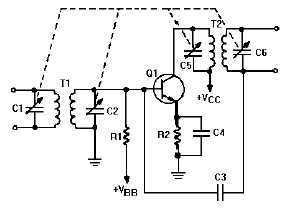8
1-64. Which of the following methods
provides the widest band-pass in an rf
amplifier?
1. A swamping resistor
2. A loosely coupled amplifier
3. A large input-signal-developing
resistor
4. A small output-signal-developing
resistor
1-65. Which of the following methods will
compensate for the problem that cause
low gain in an rf amplifier?
1. Using rf transformers
2. Taking advantage of the
interelectrode capacitance
3. Both 1 and 2 above
4. Using audio transformers
1-66. Which of the following types of feedback
is usually caused by the base-to-collector
interelectrode capacitance?
1. Regenerative
2. Decoupled
3. Positive
4. Negative
1-67. In an rf amplifier an unwanted signal is
coupled through the base-to-collector
interelectrode capacitance. This problem
can be solved by providing feedback out
of phase with the unwanted signal. What
is this technique called?
1. Neutralization
2. Compensating
3. Decoupling
4. Swamping
THIS SPACE LEFT BLANK
INTENTIONALLY.
Figure 1C.—RF amplifier.
IN ANSWERING QUESTIONS 1-68
THROUGH 1-75, REFER TO FIGURE 1C.
1-68. Which of the following components
is/are part of the input-signal-developing
impedance for Q1?
1.
C1
2.
T1
3.
C3
4. All of the above
1-69. What is the purpose of R1?
1. To provide swamping for the
secondary of T1
2. To act as an output-signal-developing
resistor
3. To provide proper bias to the base of
Q1
4. To develop the signal coupled by C3
1-70. What is the purpose of R2?
1. To provide swamping for C4
2. To develop the input signal for Q1
3. To provide bias to the emitter of Q1
4. To act as the output-signal-
developing resistor
1-71. If C4 were removed from the circuit,
what would happen to the output?
1. It would increase
2. It would decrease
3. It would remain the same
4. It cannot be determined

